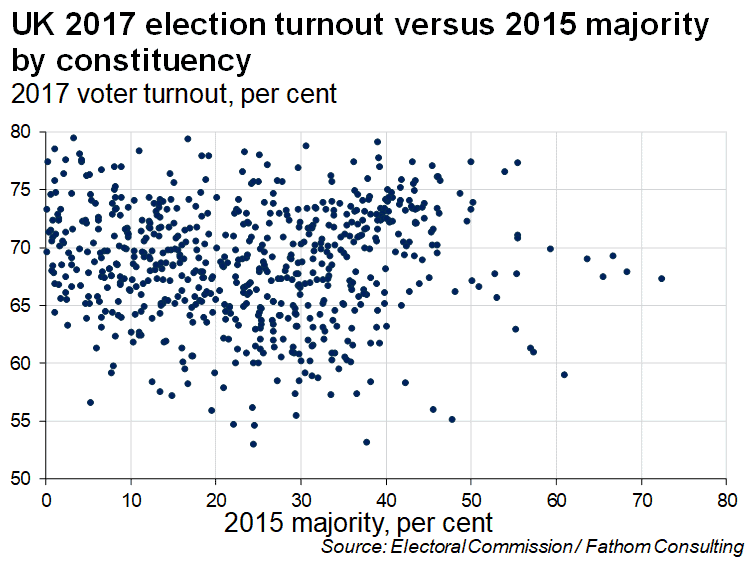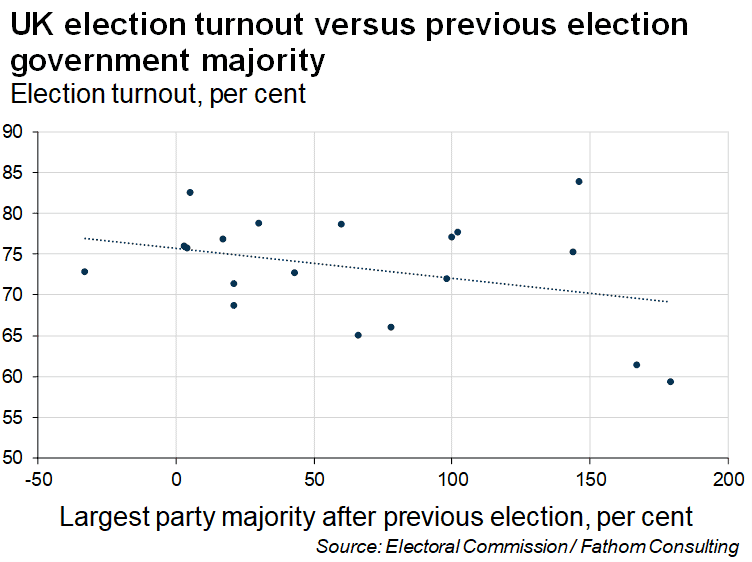A sideways look at economics
Next week, millions of UK voters will head back to the polls and cast their ballots in a general election. To those interested in politics, elections provide weeks of head-to-head debates, battle buses and the opportunity to dissect party manifestos. To others ― such as Brenda from Bristol ― the response is far less enthusiastic. While a third general election in a little over four years may seem a tad excessive, and cause many to sympathise with Brenda, turnout is still likely to be close to that of the last election when roughly two-thirds of the electorate made their way to the voting booths. But, while many commentators (including ourselves) are focusing on how people will vote, in this TFiF we ask why people vote.
Standard economic theory tells you that people do things that make them happy. Anthony Downs (1957)[1] applied this logic in an attempt to understand individuals’ decisions to vote. In a very basic model, he assumed that individuals choose to vote because they derive some form of happiness (utility) from their desired outcome. In such a model, an individual’s decision to vote is based upon the utility gained from their chosen party winning (Ui,win), the likelihood of that outcome being achieved (Pwin), and the effort required to vote (Ci):
Ei(Ui) = Pwin * Ui,win – Ci
In a simple, two-party system where voting takes place under a system of proportional representation, there are two ways that an individual can change the outcome of a vote: either they can be the individual that tips the result from a tie to a one-vote winning margin or they can be the vote that takes the result to a tie. As illustrated by Hindriks and Myles (2006)[2], the probability that an individual’s vote will be pivotal in deciding the outcome is given by:
Pi,pivotal = 0.5 * P(XA = XB) + 0.5 * P(XB – XA = 1)
where P(XA = XB) is the probability of a tie between parties A and B and P(XB – XA = 1) is the probability that party B wins by a single vote. Note here that each of these terms is multiplied by 0.5 since, in the event of a tie, UK elections are determined by the drawing of lots (yes, that’s really how it’s done).
Obviously, the probability of a two-way vote ending in a tie is extremely unlikely which implies that, if individuals do act this way, any person choosing to vote either has no cost of doing so (i.e. Ci → 0 ) or has an implausibly great desire for their preferred candidate to win (i.e. Ui,win is large). Therefore, according to the theory, there’s very little incentive for anyone to vote. Mueller (1987)[3] even quipped that the likelihood of being run over on the way to the polling booth is close to the probability that your vote changes the result.
Of course, real life is far more complex than the above simple illustration. Nowhere is this more true than in the UK, which has a multi-party system, and where power is distributed in the lower house according to an arcane and complex system known as ‘First Past the Post’ (FPTP). Indeed, if your aim as a voter is to decide who resides in Number 10, then the odds of your vote being pivotal are far smaller still. [4] Let’s assume that next week Sinn Fein retains 7 MPs. In those circumstances there would be 639 ‘active’ seats in the House of Commons (as the Speaker and Deputy Speakers don’t vote). Consequently, under FPTP a party needs 319+1 seat for a majority of 1. For your vote to be decisive next Thursday, you would need not only to tip your party in your constituency from a losing position to a tie, or from a tied position to a win, you would also need your party to be on 319 seats before your constituency is counted. Only then could you hope to tip the balance at the national level. Based on the latest polls, we estimate there is around a 2% chance that the votes in a single constituency will determine whether the outcome is a hung parliament, or an outright majority.
In any case, a quick look at the constituency-level voting patterns in the 2017 election yields little evidence that tight winning margins in 2015 increased voter turnout in marginal seats. And, while there is at least some correlation between voter turnout and the previous election’s winning margin, it’s far from conclusive.


Regardless, voters still turn out in large numbers, even though economics may struggle to explain it. Perhaps people simply vote because they like doing it, even if their preferred candidate doesn’t win. There’s nothing wrong with that; in fact, there’s a lot right with that. Many countries in the world aren’t lucky enough to hold free elections like the UK. It’s a privilege that we enjoy, and one that we should definitely take advantage of, even if the choice isn’t that great.
[1] Downs, A., An economic theory of democracy, Harper 1957.
[2] Hindricks, J. and Myles, G.D., Intermediate Public Economics, MIT Press 2006.
[3] Mueller, D.C., ‘The voting paradox’, in Rowley, C.K., Democracy and Public Choice, Basil Blackwell 1987.
[4] Of course, there are more than two candidates standing in most seats. If your party of choice is the Official Monster Raving Looney Party (OMRLP), for example, then you have absolutely no chance of influencing the outcome at the national level, not least because OMRLP is fielding only 24 candidates across the UK’s 650 constituencies. Most UK constituencies are what is known as two-way marginals, which means you only stand even a slim chance of influencing the outcome in your seat if you happen to support one of the two parties in contention (one of which will always be the Lib Dems, of course).